Primary Interannual Variability Patterns of the Growing-Season NDVI over the Tibetan Plateau and Main Climatic Factors
Abstract
:1. Introduction
2. Data and Methods
2.1. Data
2.2. The Area and Season of the Study
2.3. Methods
3. Results
3.1. Characteristics of Interannual Variability in the TP NDVI
3.2. Local Climatic Factors Influencing Interannual Variability in the TP NDVI
4. Discussion
5. Conclusions
Supplementary Materials
Author Contributions
Funding
Data Availability Statement
Acknowledgments
Conflicts of Interest
References
- Keeling, C.D.; Chin, J.F.S.; Whorf, T.P. Increased activity of northern vegetation inferred from atmospheric CO2 measurements. Nature 1996, 382, 146–149. [Google Scholar] [CrossRef]
- Cao, M.K.; Woodward, F.I. Dynamic responses of terrestrial ecosystem carbon cycling to global climate change. Nature 1998, 393, 249–252. [Google Scholar] [CrossRef]
- Sun, H.Y.; Wang, C.Y.; Niu, Z. Analysis of the Vegetation Cover Change and the Relationship between NDVI and Environmental Factors by Using NOAA Time Series Data. J. Remote Sens. 1998, 2, 204–210. (In Chinese) [Google Scholar] [CrossRef]
- Weiss, J.L.; Gutzler, D.S.; Allred Coonrod, J.E.; Dahm, C.N. Seasonal and inter-annual relationships between vegetation and climate in central New Mexico, USA. J. Arid Environ. 2004, 57, 507–534. [Google Scholar] [CrossRef]
- Nezlin, N.P.; Kostianoy, A.G.; Li, B.L. Inter-annual variability and interaction of remote-sensed vegetation index and atmospheric precipitation in the Aral Sea region. J. Arid Environ. 2005, 62, 677–700. [Google Scholar] [CrossRef]
- Shukla, J.; Nobre, C.; Sellers, P. Amazon deforestation and climatem change. Science 1990, 247, 1322–1325. [Google Scholar] [CrossRef] [PubMed] [Green Version]
- Zhang, J.Y.; Dong, W.J.; Fu, C.; Wu, L.Y. The influence of vegetation cover on summer precipitation in China: A statistical analysis of NDVI and climate data. Adv. Atmos. Sci. 2003, 20, 1002–1006. [Google Scholar] [CrossRef]
- Li, W.P.; Xue, Y.K. Numerical simulation of the impact of vegetation index on the interannual variation of summer precipitation in the Yellow River Basin. Adv. Atmos. Sci. 2005, 22, 865–876. [Google Scholar] [CrossRef]
- Zhang, J.; Walsh, J.E. Thermodynamic and hydrological impacts of increasing greenness in Northern high latitudes. J. Hydrometeorol. 2006, 7, 1147–1163. [Google Scholar] [CrossRef]
- Liu, Y.Q.; Fan, G.Z.; Zhou, D.W.; Li, H.Q.; Hua, W.; Li, X.M. Variability of NDVI in Winter and Spring on the Tibetan Plateau and their Relationship with Summer Precipitation. Acta Meteorol. Sin. 2007, 65, 959–967. [Google Scholar] [CrossRef]
- Hua, W.; Fan, G.Z.; Zhou, D.W.; Ni, C.J.; Li, X.M.; Wang, Y.L.; Liu, Y.Q.; Huang, X.L. Preliminary analysis on the relationships between Tibetan Plateau NDVI change and its surface heat source and precipitation of China. Sci. China. Ser. D Earth Sci. 2008, 51, 677–685. [Google Scholar] [CrossRef]
- Wang, Y.X.; Zhao, P.; Yu, R.C.; Rasul, G. Inter-decadal variability of Tibetan spring vegetation and its associations with eastern China spring rainfall. Int. J. Climatol. 2009, 30, 856–865. [Google Scholar] [CrossRef]
- Zuo, Z.; Zhang, R.; Zhao, P. The relation of vegetation over the Tibetan Plateau to rainfall in China during the boreal summer. Clim. Dyn. 2011, 36, 1207–1219. [Google Scholar] [CrossRef]
- Csiszar, I.; Gutman, G. Global high-resolution land surface albedo monthly maps from NOAA/AVHRR for use in climate models. IEEE Int. Geosci. Remote Sens. Symp. Proc. 1998, 2, 710–712. [Google Scholar] [CrossRef]
- Fang, S.B.; Yu, W.G.; Qi, Y. Spectra and vegetation index variations in moss soil crust in different seasons, and in wet and dry conditions. Int. J. Appl. Earth Obs. Geoinf. 2015, 38, 261–266. [Google Scholar] [CrossRef]
- Huang, X.L.; Zhang, T.B.; Yi, G.H.; He, D.; Zhou, X.B.; Li, J.; Bie, X.; Miao, J. Dynamic Changes of NDVI in the Growing Season of the Tibetan Plateau during the Past 17 Years and Its Response to Climate Change. Int. J. Environ. Res. Public Health 2019, 16, 3452. [Google Scholar] [CrossRef] [Green Version]
- Mao, D.H.; Wang, Z.M.; Ling, L.; Ren, C.Y. Integrating AVHRR and MODIS data to monitor NDVI changes and their relationships with climatic parameters in Northeast China. Int. J. Appl. Earth Obs. Geoinf. 2012, 18, 528–536. [Google Scholar] [CrossRef]
- Sun, J.; Cheng, G.; Li, W.; Sha, Y.; Yang, Y. On the Variation of NDVI with the Principal Climatic Elements in the Tibetan Plateau. Remote Sens. 2013, 5, 1894–1911. [Google Scholar] [CrossRef] [Green Version]
- Liu, S.H.; Yan, D.H.; Shi, X.L.; Yuan, Z. Inter-annual variability of vegetation NDVI, accumulated temperature and precipitation and their correlations in China. Arid Land Geogr. 2014, 37, 480–489. (In Chinese) [Google Scholar]
- Fang, S.B.; Zhang, X.S. Control of vegetation distribution: Climate, geological substrate, and geomorphic factors. A case study of grassland in Ordos, Inner Mongolia, China. Can. J. Remote Sens. 2013, 39, 167–174. [Google Scholar] [CrossRef]
- Shen, B.; Fang, S.B.; Li, G. Vegetation coverage changes and their response to meteorological variables from 2000 to 2009 in Naqu, Tibet, China. Can. J. Remote Sens. 2014, 40, 67–74. [Google Scholar] [CrossRef]
- Shen, B.; Fang, S.B.; Yu, W.G. Different correlations between NDVI and meteorological factors at temporal-time scales. J. Remote Sens. 2016, 20, 481–490. [Google Scholar] [CrossRef]
- Zhao, Q.Q.; Zhang, J.P.; Zhao, T.B.; Li, J.H. Vegetation Changes and Its Response to Climate Change in China Since 2000. Plateau Meteorol. 2021, 40, 292–301. (In Chinese) [Google Scholar] [CrossRef]
- Li, Z.; Yan, F.L.; Fan, X.T. The Variability of NDVI over Northwest China and Its Relation to Temperature and Precipitation. J. Remote Sens. 2005, 9, 308–313. (In Chinese) [Google Scholar] [CrossRef]
- Ding, M.J.; Zhang, Y.L.; Liu, L.S.; Wang, Z.F. Temporal and spatial distribution of grassland coverage change in Tibetan Plateau since 1982. J. Nat. Resour. 2010, 25, 2114–2122. [Google Scholar] [CrossRef]
- Meng, M.; Niu, Z.; Ma, C.; Tian, H.F. Variation Trend of NDVI and Response to Climate Change in Tibetan Plateau. Res. Soil Water Conserv. 2018, 25, 360–372. (In Chinese) [Google Scholar] [CrossRef]
- Wang, Q.X.; Lü, S.H.; Bao, Y.; Ma, D.; Li, R.Q. Characteristics of Vegetation Change and Its Relationship with Climate Factors in Different Time-Scales on Qinghai-Xizang Plateau. Plateau Meteorol. 2014, 33, 301–312. (In Chinese) [Google Scholar] [CrossRef]
- Du, J.; Zhao, C.; Shu, J.; Jiaerheng, A.; Yuan, X.; Yin, J.; Fang, S.; He, P. Spatiotemporal changes of vegetation on the Tibetan Plateau and relationship to climatic variables during multiyear periods from 1982–2012. Environ. Earth Sci. 2016, 75, 77. [Google Scholar] [CrossRef]
- Zhang, Y.W.; Wang, D.H.; Zhai, P.M.; Gu, G.J.; He, J.H. Spatial Distributions and Seasonal Variations of Tropospheric Water Vapor Content over the Tibetan Plateau. J. Clim. 2013, 26, 5637–5654. [Google Scholar] [CrossRef]
- Wang, S.; Wang, X.; Chen, G.; Yang, Q.; Wang, B.; Ma, Y.; Shen, M. Complex responses of spring alpine vegetation phenology to snow cover dynamics over the Tibetan Plateau, China. Sci. Total Environ. 2017, 593–594, 449–461. [Google Scholar] [CrossRef]
- Gao, Q.; Guo, Y.; Xu, H.; Ganjurjav, H.; Li, Y.; Wan, Y.; Qin, X.; Ma, X.; Liu, S. Climate change and its impacts on vegetation distribution and net primary productivity of the alpine ecosystem in the Qinghai-Tibetan Plateau. Sci. Total Environ. 2016, 554–555, 34–41. [Google Scholar] [CrossRef] [PubMed]
- Pang, G.J.; Wang, X.J.; Yang, M.X. Using the NDVI to identify variations in, and responses of, vegetation to climate change on the Tibetan Plateau from 1982 to 2012. Quat. Int. 2017, 444, 87–96. [Google Scholar] [CrossRef]
- Jiang, Y.C.; Li, D.L.; Zheng, R. Variation characteristics of snow cover and frozen soil and their relationships with vegetation in the Tibetan Plateau from 1971 to 2016. Trans. Atmos. Sci. 2020, 43, 481–494. (In Chinese) [Google Scholar] [CrossRef]
- Li, Q.; Zhang, C.L.; Wang, R.D.; Zhou, N. Climate change and impact on desertification in Qinghai-Tibet Plateau from 1965–2016. J. Beijing Norm. Univ. Nat. Sci. 2018, 54, 659–665. (In Chinese) [Google Scholar] [CrossRef]
- Cao, X.J.; Ganjurjav, H.; Liang, Y.; Gao, Q.Z.; Zhang, Y.; Li, Y.E.; Wan, Y.F.; Danjiu, L.B. Temporal and spatial distribution of grassland degradation in northern Tibet based on NDVI. Acta Pratacult. Sin. 2016, 25, 1–8. (In Chinese) [Google Scholar] [CrossRef]
- Li, W.X.; Xu, J.; Yao, Y.Q.; Zhang, Z.C. Temporal and Spatial Changes in the Vegetation Cover (NDVI) in the Three-River Headwater Region, Tibetan Plateau, China under Global Warming. Mt. Res. 2021, 39, 473–482. (In Chinese) [Google Scholar] [CrossRef]
- Gao, Q.; Li, Y.; Wan, Y.F.; Wan, Y.; Lin, E.; Xiong, W.; Wangzha, J.; Wang, B.; Wenfu, L. Grassland degradation in Northern Tibet based on remote sensing data. J. Geogr. Sci. 2006, 16, 165–173. [Google Scholar] [CrossRef]
- Liang, S.H.; Chen, J.; Jin, X.M.; Wan, L.; Gong, B. Regularity of Vegetation Coverage Changes in the Tibetan Plateau over the Last 21 Years. Adv. Earth Sci. 2007, 22, 33–40. (In Chinese) [Google Scholar] [CrossRef]
- Liu, J.Y.; Xu, X.L.; Sao, Q.Q. The Spatial and Temporal Characteristics of Grassland Degradation in the Three-River Headwaters Region in Qinghai Province. J. Geogr. Sci. 2008, 18, 364–376. [Google Scholar] [CrossRef]
- Lu, Q.; Wu, S.H.; Zhao, D.S. Variations in Alpine Grassland Cover and Its Correlation with Climate Variables on the Qinghai-Tibet Plateau in 1982–2013. Sci. Geogr. Sin. 2017, 37, 292–300. (In Chinese) [Google Scholar] [CrossRef]
- Hua, Y.; Wang, S.; Jiang, J.; Zhou, W.; Xu, Q.; Li, X.; Liu, B.; Zhang, D.; Zheng, M. Characteristics and sources of aerosol pollution at a polluted rural site southwest in Beijing, China. Sci. Total Environ. 2018, 626, 519–527. [Google Scholar] [CrossRef] [PubMed]
- Yang, Y.H.; Piao, S.L. Variation in grassland vegetation cover in relation to climatic factors on the Tibetan Plateau. J. Plant Ecol. 2006, 1, 1–8. (In Chinese) [Google Scholar] [CrossRef]
- Zhuo, G.; Chen, S.R.; Zhou, B. Spatio-temporal variation of vegetation coverage over the Tibetan Plateau and its responses to climatic factors. Acta Ecol. Sin. 2018, 38, 3208–3218. (In Chinese) [Google Scholar] [CrossRef]
- Yeh, T.C. Some aspects of the thermal influences of the Qinghai-Tibetan Plateau on the atmospheric circulation. Arch. Met. Geoph. Biokl. Ser. A 1982, 31, 205–220. [Google Scholar] [CrossRef]
- Chen, L.X.; Reiter, E.R.; Feng, Z.Q. The atmospheric heat source over the Tibetan Plateau: May–August 1979. Mon. Weather Rev. 1985, 113, 1741–1791. [Google Scholar] [CrossRef]
- Zhao, P.; Chen, L.X. Interannual variability of atmospheric heat source/sink over the Qinghai-Xizang (Tibetan) Plateau and its relation to circulation. Adv. Atmos. Sci. 2001, 18, 106–116. [Google Scholar] [CrossRef]
- Wu, G.; Liu, Y.; Zhang, Q.; Duan, A.; Wang, T.; Wan, R.; Liu, X.; Li, W.; Wang, Z.; Liang, X. The Influence of the Mechanical and Thermal Forcing of the Tibetan Plateau on the Asian Climate. J. Hydrometeor. 2007, 8, 770–789. [Google Scholar] [CrossRef] [Green Version]
- Wang, B.; Bao, Q.; Hoskins, B.; Wu, G.X.; Liu, Y.M. Tibetan Plateau warming and precipitation changes in East Asia. Geophys. Res. Lett. 2008, 35, L14702. [Google Scholar] [CrossRef] [Green Version]
- Liu, G.; Zhao, P.; Nan, S.; Chen, J.; Wang, H. Advances in the study of linkage between the tibetan plateau thermal anomaly and atmospheric circulations over its upstream and downstream regions. Acta Meteorol. Sin. 2018, 76, 861–869. (In Chinese) [Google Scholar] [CrossRef]
- Huete, A.; Didan, K.; Miura, T.; Rodriguez, E.P.; Gao, X.; Ferreira, L.G. Overview of the radiometric and biophysical performance of the MODIS vegetation indices. Remote Sens. Environ. 2002, 83, 195–213. [Google Scholar] [CrossRef]
- Weltzin, J.F.; Loik, M.E.; Schwinning, S.; Williams, D.G.; Fay, P.A.; Haddad, B.M.; Harte, J.; Huxman, T.E.; Knapp, A.K.; Lin, G.; et al. Assessing the response of terrestrial ecosystems to potential changes in precipitation. BioScience 2003, 53, 941–952. [Google Scholar] [CrossRef]
- Sarkar, S.; Kafatos, M. Interannual variability of vegetation over the Indian sub-continent and its relation to the different meteorological parameters. Remote Sens. Environ. 2004, 90, 268–280. [Google Scholar] [CrossRef]
- Notaro, M.; Williams, M.J.W. Projected vegetation changes for the American Southwest: Combined dynamic modeling and bioclimatic-envelope approach. Ecol. Appl. 2012, 22, 1365–1388. [Google Scholar] [CrossRef] [PubMed]
- Jiang, X.; Rauscher, S.A.; Ringler, T.D.; Lawrence, D.M.; Williams, A.P.; Allen, C.D.; Steiner, A.L.; Cai, D.M.; McDowell, N.G. Projected Future Changes in Vegetation in Western North America in the Twenty-First Century. J. Clim. 2013, 26, 3671–3687. [Google Scholar] [CrossRef]
- Yu, M.; Wang, G.L.; Parr, D.; Ahmed, K.F. Future changes of the terrestrial ecosystem based on a dynamic vegetation model driven with RCP8.5 climate projections from 19 GCMs. Clim. Chang. 2014, 127, 257–271. [Google Scholar] [CrossRef]
- Sun, J. Study on the biomass characteristics and their allocation mechanism in Tibetan alpine grassland. Ph.D. Thesis, University of Chinese Academy of Sciences, Beijing, China, 2013. (In Chinese). [Google Scholar]
- Fensholt, R.; Rasmussen, K.; Nielsen, T.T.; Mbow, C. Evaluation of earth observation based long term vegetation trends—Intercomparing NDVI time series trend analysis consistency of Sahel from AVHRR GIMMS. Terra MODIS and SPOT VGT data. Remote Sens. Environ. 2009, 113, 1886–1898. [Google Scholar] [CrossRef]
- Alcaraz-Segura, D.; Liras, E.; Tabik, S.; Paruelo, J.; Cabello, J. Evaluating the consistency of the 1982–1999 NDVI trends in the Iberian Peninsula across four time-series derived from the AVHRR sensor. LTDR, GIMMS, FASIR, and PAL-II. Sensors 2010, 10, 1291–1314. [Google Scholar] [CrossRef] [PubMed]
- Chen, Y.L.; Long, B.J.; Pan, X.B.; Zhong, S.Q.; Mo, W.H. Differences between MODIS NDVI and AVHRR NDVI in monitoring grasslands change. J. Remote Sens. 2011, 15, 831–845. [Google Scholar] [CrossRef] [Green Version]
- Fensholt, R.; Rasmussen, K. Analysis of trends in the Sahelian ‘rain-use efficiency’ using GIMMS NDVI, RFE and GPCP rainfall data. Remote Sens. Environ. 2011, 115, 438–451. [Google Scholar] [CrossRef]
- Du, J.Q.; Shu, J.M.; Wang, Y.H.; Li, Y.C.; Zhang, L.B.; Guo, Y. Comparison of GIMMS and MODIS normalized vegetation index composite data for Qinghai-Tibet Plateau. Chin. J. Appl. Ecol. 2015, 25, 533–544. (In Chinese) [Google Scholar]
- Beck, H.E.; Mcvicar, T.R.; Dijk, A.; Schellekens, J.; Jeu, R.; Bruijnzeel, L.A. Global evaluation of four AVHRR-NDVI data sets: Intercomparison and assessment against Landsat imagery. Remote Sens. Environ. 2011, 115, 2547–2563. [Google Scholar] [CrossRef]
- Liu, S.Y.; Zhang, L.; Wang, C.Z. Vegetation Phenology in the Tibetan Plateau Using MODIS Data from 2000 to 2010. Remote Sens. Inf. 2014, 29, 25–30. (In Chinese) [Google Scholar]
- Gallo, K.; Li, J.; Reed, B.; Eidenshink, J.; Dwyer, J. Multi-platform comparisons of MODIS and AVHRR normalized difference vegetation index data. Remote Sens. Environ. 2005, 99, 221–231. [Google Scholar] [CrossRef]
- Fensholt, R.; Proud, S.R. Evaluation of Earth Observation based global long term vegetation trends - Comparing GIMMS and MODIS global NDVI time series. Remote Sens. Environ. 2012, 119, 131–147. [Google Scholar] [CrossRef]
- Beck, P.; Goetz, S.J. Satellite observations of high northern latitude vegetation productivity changes between 1982 and 2008: Ecological variability and regional differences. Environ. Res. Lett. 2011, 6, 45501–45510. [Google Scholar] [CrossRef]
- North, G.R.; Bell, T.L.; Cahalan, R.F.; Moeng, F.J. Sampling errors in the estimation of empirical orthogonal function. Mon. Weather Rev. 1982, 110, 699–706. [Google Scholar] [CrossRef]
- Liu, M.G. Atlas of Physical Geography of China, 3rd ed.; Sinomap Press: Beijing, China, 2010. (In Chinese) [Google Scholar]
- Zhang, W.J.; Gao, Z.Q. Study on The Response of Vegetation Cover to Precipitation and Temperature in Central/East Tibetan Plateau. Prog. Geogr. 2005, 24, 13–22. (In Chinese) [Google Scholar] [CrossRef]
- Braswell, B.H.; Schimel, D.S.; Under, E.; Moore, B. The response of global terrestrial ecosystems to interannual temperature variability. Science 1997, 278, 870–872. [Google Scholar] [CrossRef]
- Potter, C.S.; Brooks, V. Global analysis of empirical relations between annual climate and seasonality of NDVI. Int. J. Remote Sens. 1998, 19, 2921–2948. [Google Scholar] [CrossRef]
- Li, X.; Li, X.B.; Chen, Y.H.; Ying, G. Temporal Response of Vegetation to Climate Variables in Temperate Steppe of Northern China. Chin. J. Plant. Ecol. 2007, 31, 1054–1062. [Google Scholar] [CrossRef]
- Zhao, Y.P.; Zhang, X.Z.; Wang, J.S.; Shen, Z.X. Correlation Analysis between NDVI and Climatic Factors of Grassland Ecosystems in the Northern Tibetan Plateau from 1982 to 2003. Resour. Sci. 2009, 31, 1988–1998. (In Chinese) [Google Scholar] [CrossRef]
- Huang, K.; Zhang, Y.; Zhu, J.; Liu, Y.; Zu, J.; Zhang, J. The Influences of Climate Change and Human Activities on Vegetation Dynamics in the Qinghai-Tibet Plateau. Remote Sens. 2016, 8, 876. [Google Scholar] [CrossRef] [Green Version]
- Zhang, R.H.; Su, F.G.; Jiang, Z.H.; Gao, X.J. An overview of projected climate and environmental changes across the Tibetan Plateau in the 21st century. Chin. Sci. Bull. 2015, 60, 3036–3047. (In Chinese) [Google Scholar] [CrossRef]
- Wang, Z.P.; Zhang, X.Z.; He, Y.T.; Li, M.; Shi, P.L.; Zu, J.X.; Niu, B. Responses of normalized difference vegetation index (NDVI) to precipitation changes on the grassland of Tibetan Plateau from 2000 to 2015. Chin. J. Appl. Ecol. 2018, 29, 75–83. (In Chinese) [Google Scholar] [CrossRef]
- Xu, G.; Zhang, H.; Chen, B.; Zhang, H.; Innes, J.L.; Wang, G.; Yan, J.; Zheng, Y.; Zhu, Z.; Myneni, R.B. Changes in Vegetation Growth Dynamics and Relations with Climate over China’s Landmass from 1982 to 2011. Remote Sens. 2014, 6, 3263–3283. [Google Scholar] [CrossRef] [Green Version]
- Dong, W.; Lin, Y.; Wright, J.S.; Ming, Y.; Xie, Y.; Wang, B.; Luo, Y.; Huang, W.; Huang, J.; Wang, L.; et al. Summer rainfall over the southwestern Tibetan Plateau controlled by deep convection over the Indian subcontinent. Nat. Commun. 2016, 7, 10925. [Google Scholar] [CrossRef] [PubMed] [Green Version]
- Jiang, X.; Ting, M.A. Dipole Pattern of Summertime Rainfall across the Indian Subcontinent and the Tibetan Plateau. J. Clim. 2017, 30, 9607–9620. [Google Scholar] [CrossRef]
- Liu, X.; Yin, Z.-Y. Spatial and temporal variation of summer precipitation over the eastern Tibetan Plateau and the North Atlantic Oscillation. J. Clim. 2001, 14, 2896–2909. [Google Scholar] [CrossRef]
- Liu, H.; Duan, K.; Li, M.; Shi, P.; Yang, J.; Zhang, X.; Sun, J. Impact of the North Atlantic Oscillation on the dipole oscillation of summer precipitation over the central and eastern Tibetan Plateau. Int. J. Climatol. 2015, 35, 4539–4546. [Google Scholar] [CrossRef]
- Wang, Z.Q.; Duan, A.; Yang, S.; Ullah, K. Atmospheric moisture budget and its regulation on the variability of summer precipitation over the Tibetan Plateau. J. Geophys. Res. Atmos. 2017, 122, 614–630. [Google Scholar] [CrossRef]
- Gao, Y.; Wang, H.; Li, S. Influences of the Atlantic Ocean on the summer precipitation of the southeastern Tibetan Plateau. J. Geophys. Res. Atmos. 2013, 118, 3534–3544. [Google Scholar] [CrossRef]
- Chen, X.Y.; You, Q.L. Effect of Indian Ocean SST on Tibetan Plateau precipitation in the early rainy season. J. Clim. 2017, 30, 8973–8985. [Google Scholar] [CrossRef]
- He, K.; Liu, G.; Zhao, J.; Li, J. Co-variability of the summer NDVIs on the eastern Tibetan Plateau and in the Lake Baikal region: Associated climate factors and atmospheric circulation. PLoS ONE 2020, 15, e0239465. [Google Scholar] [CrossRef] [PubMed]
- Xu, J.J.; Lu, J. Precipitation over the Qinghai-Xizang Plateau in summer and its association with the Eurasian snow cover. J. Nanjing Inst. Meteor. 1992, 15, 517–524. (In Chinese) [Google Scholar]
- Wang, H.; Liu, G.; Wang, S.; He, K. Precursory Signals (SST and Soil Moisture) of Summer Surface Temperature Anomalies over the Tibetan Plateau. Atmosphere 2021, 12, 146. [Google Scholar] [CrossRef]
- He, K.; Liu, G.; Wu, R.; Nan, S.; Wang, S.; Zhou, C.; Qi, D.; Mao, X.; Wang, H.; Wei, X. Oceanic and land relay effects in the link between spring sea surface temperatures in the Indian Ocean and summer precipitation over the Tibetan Plateau. Atmos. Res. 2022, 266, 105953. [Google Scholar] [CrossRef]
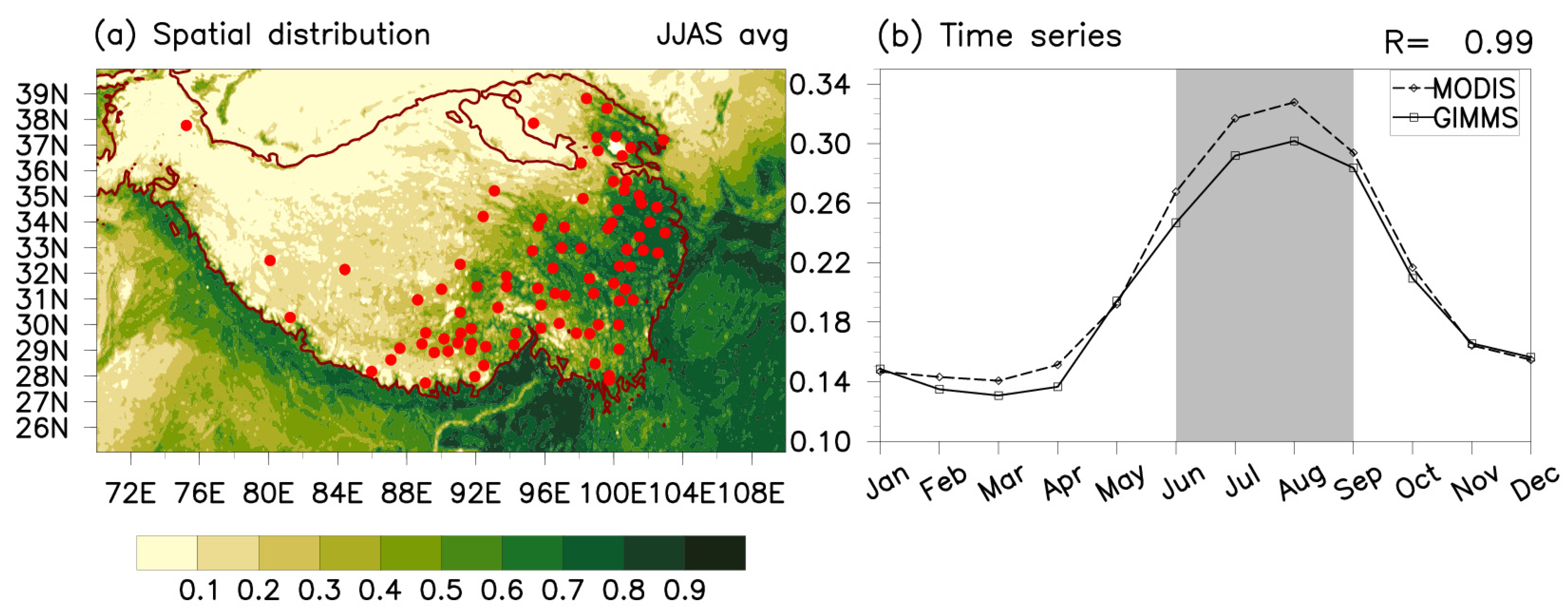
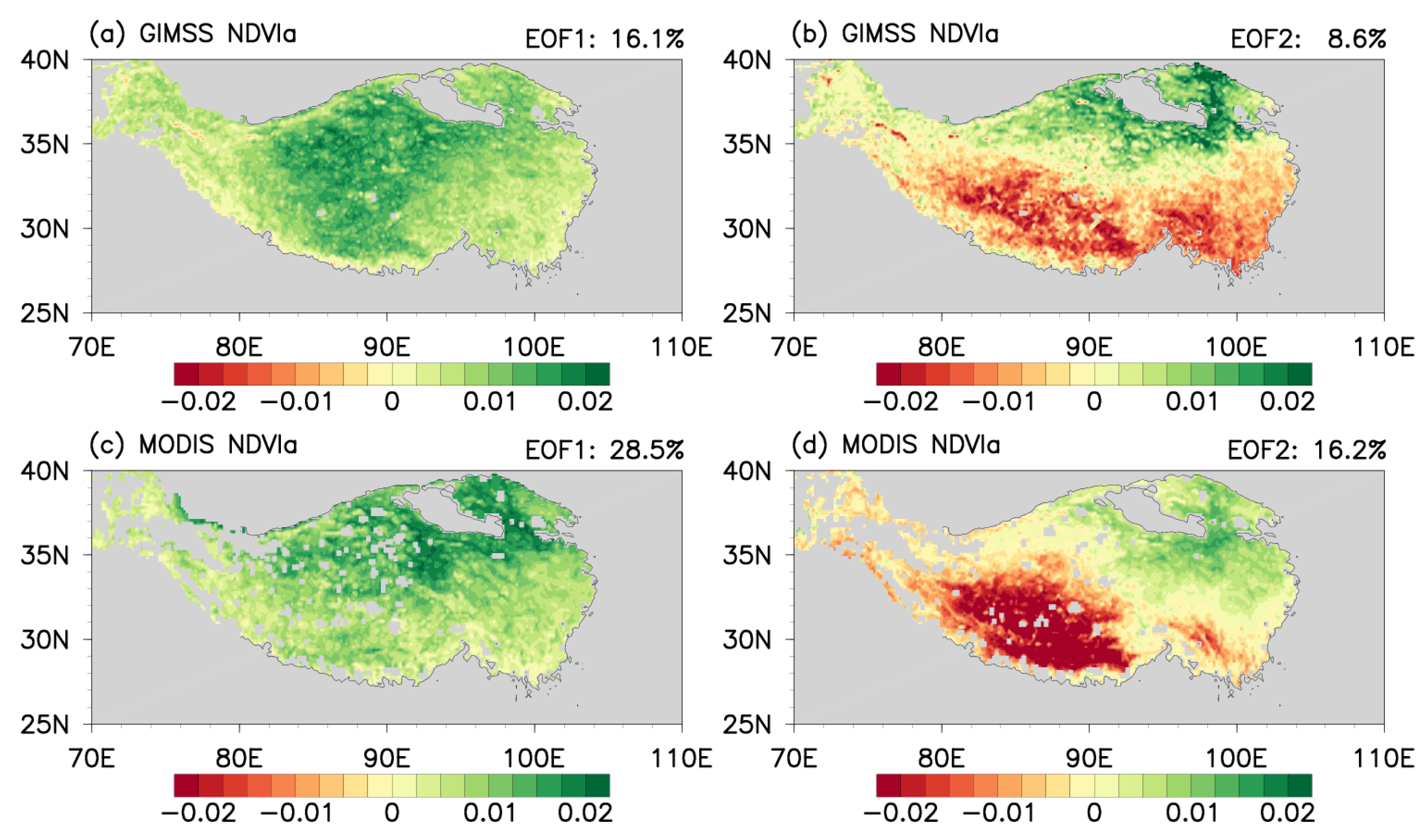
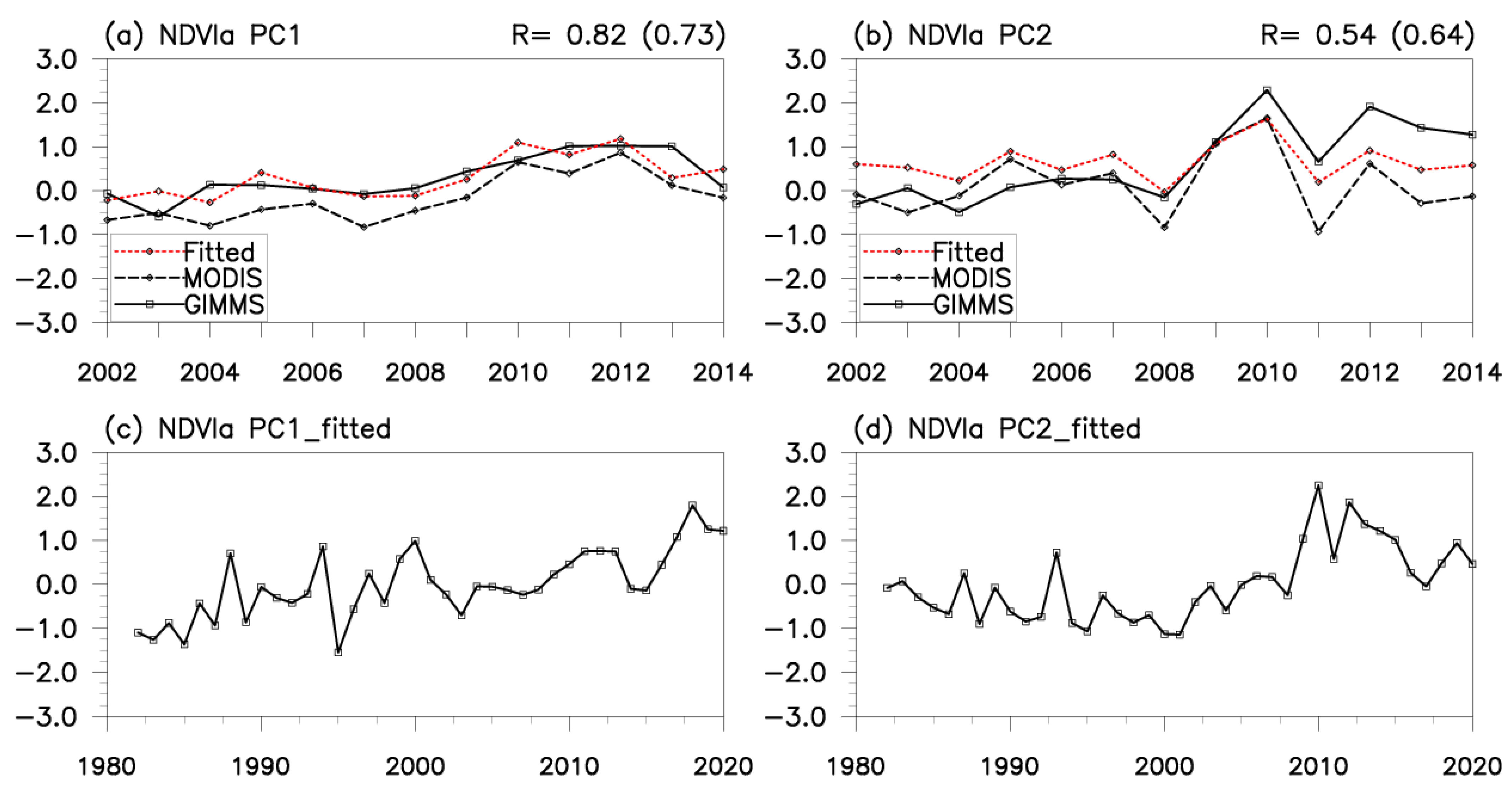

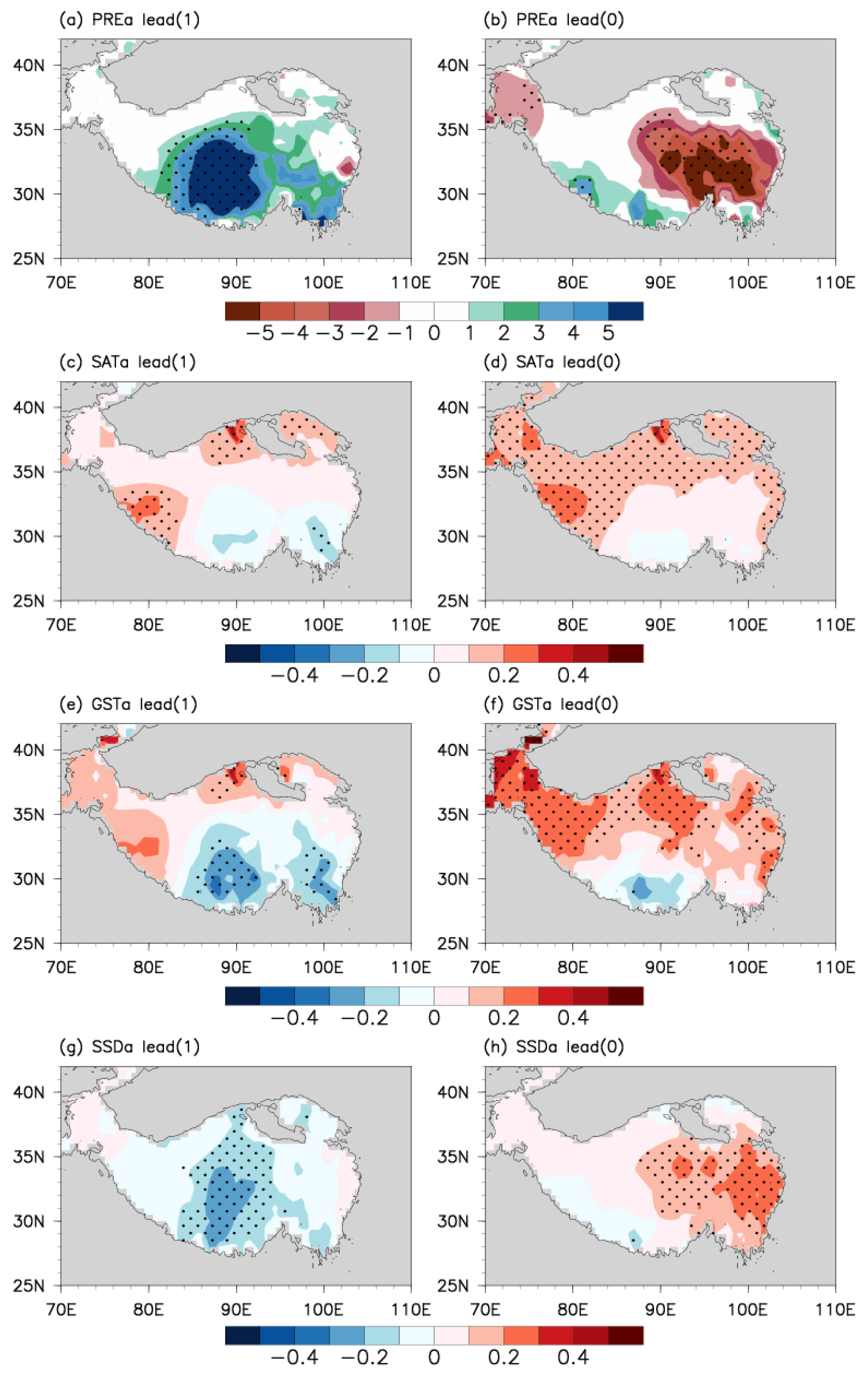

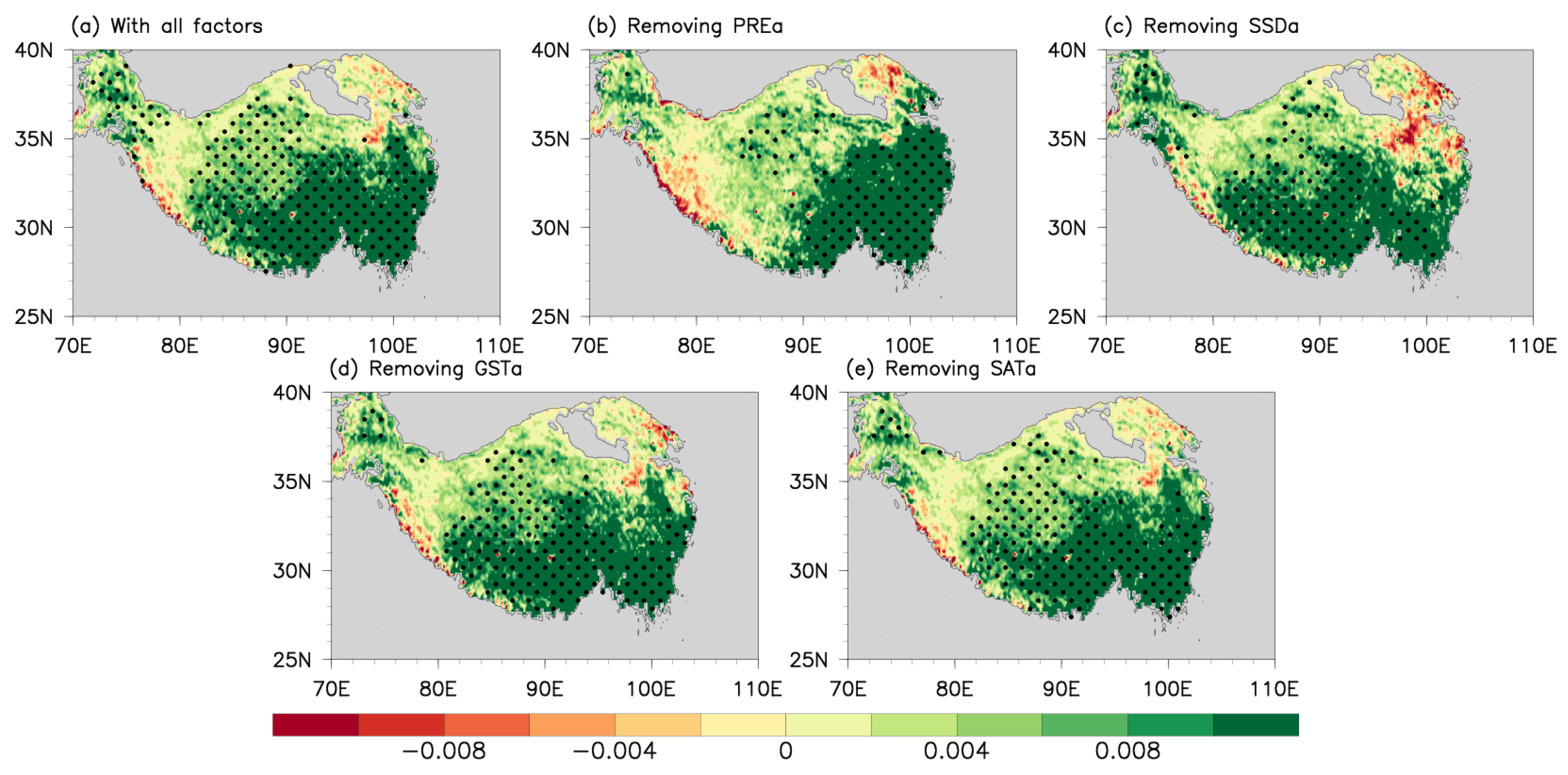
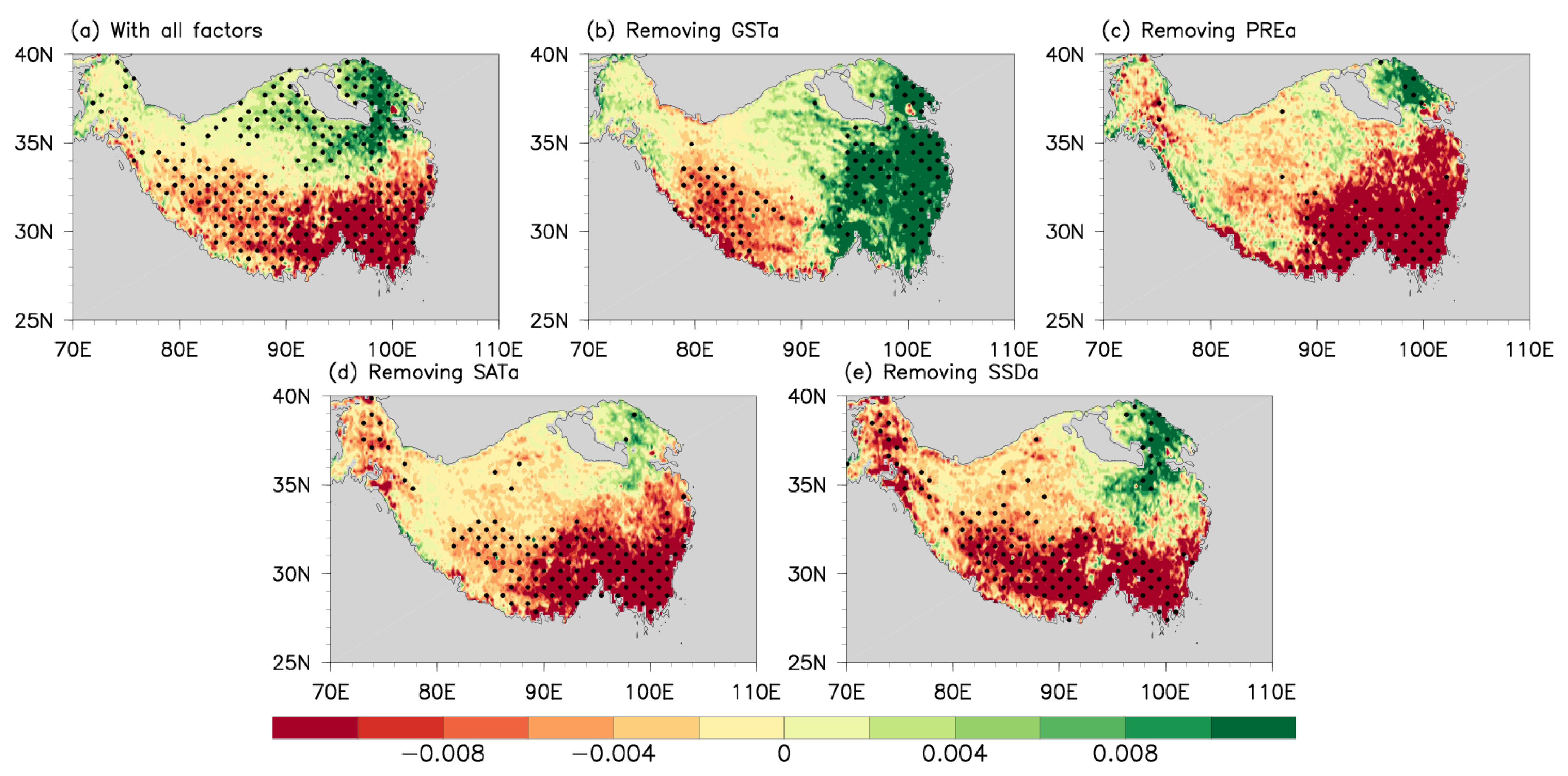
| Indices | Uniform NDVI Pattern | Dipole NDVI Pattern |
|---|---|---|
| PRE | Area-mean PRE anomalies over (28–35°N, 80–92°E) in MJJA. | Difference between area-mean PRE anomalies over (33–40°N, 91–104°E) and that over (28–33°N, 81–94°E) in MJJA. |
| SAT | Area-mean SAT anomalies over (34–40°N, 70–104°E) in JJAS. | Area-mean SAT anomalies over (33–40°N, 70–104°E) in JJAS. |
| GST | Area-mean GST anomalies over (33–40°N, 70–104°E) in JJAS. | Area-mean GST anomalies over (34–40°N, 70–104°E) in JJAS. |
| SSD | Area-mean SSD anomalies over (30–35°N, 90–104°N) in JJAS. | Area-mean SSD anomalies over (28–30°N, 76–104°N]) in JJAS. |
Publisher’s Note: MDPI stays neutral with regard to jurisdictional claims in published maps and institutional affiliations. |
© 2022 by the authors. Licensee MDPI, Basel, Switzerland. This article is an open access article distributed under the terms and conditions of the Creative Commons Attribution (CC BY) license (https://creativecommons.org/licenses/by/4.0/).
Share and Cite
Mao, X.; Ren, H.-L.; Liu, G. Primary Interannual Variability Patterns of the Growing-Season NDVI over the Tibetan Plateau and Main Climatic Factors. Remote Sens. 2022, 14, 5183. https://doi.org/10.3390/rs14205183
Mao X, Ren H-L, Liu G. Primary Interannual Variability Patterns of the Growing-Season NDVI over the Tibetan Plateau and Main Climatic Factors. Remote Sensing. 2022; 14(20):5183. https://doi.org/10.3390/rs14205183
Chicago/Turabian StyleMao, Xin, Hong-Li Ren, and Ge Liu. 2022. "Primary Interannual Variability Patterns of the Growing-Season NDVI over the Tibetan Plateau and Main Climatic Factors" Remote Sensing 14, no. 20: 5183. https://doi.org/10.3390/rs14205183
APA StyleMao, X., Ren, H.-L., & Liu, G. (2022). Primary Interannual Variability Patterns of the Growing-Season NDVI over the Tibetan Plateau and Main Climatic Factors. Remote Sensing, 14(20), 5183. https://doi.org/10.3390/rs14205183








